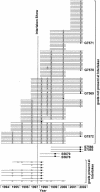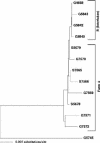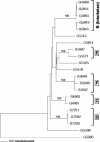Direct evidence for natural transmission of small-ruminant lentiviruses of subtype A4 from goats to sheep and vice versa
- PMID: 15220425
- PMCID: PMC434116
- DOI: 10.1128/JVI.78.14.7518-7522.2004
Direct evidence for natural transmission of small-ruminant lentiviruses of subtype A4 from goats to sheep and vice versa
Abstract
Small-ruminant lentiviruses (SRLV), which include the caprine arthritis-encephalitis and the maedi-visna virus, cause persistent inflammatory infections in goats and sheep. SRLV are mainly transmitted from mother to offspring through milk. Transmission after prolonged contact between adult animals has also been observed. The observation that certain SRLV subtypes are found in both goats and sheep suggests that interspecies transmission has occurred on several occasions in the past. We investigated seropositive goats and sheep that were kept together in small mixed herds. Phylogenetic analysis of long proviral sequences in gag and pol, combined with epidemiologic information, demonstrated natural sheep-to-goat transmission of the recently identified SRLV subtype A4 in two instances and goat-to-sheep transmission of the same subtype in one instance. In a further mixed cluster, the direction of the interspecies transmission could not be determined. These findings present for the first time direct evidence that natural interspecies transmission of SRLV is ongoing in both directions. The findings are of relevance to virus eradication programs in both species.
Figures



References
-
- Banks, K. L., D. S. Adams, T. C. McGuire, and J. Carlson. 1983. Experimental infection of sheep by caprine arthritis-encephalitis virus and goats by progressive pneumonia virus. Am. J. Vet. Res. 44:2307-2311. - PubMed
-
- Bertoni, G., C. Hertig, M. L. Zahno, H. R. Vogt, S. Dufour, P. Cordano, E. Peterhans, W. P. Cheevers, P. Sonigo, and G. Pancino. 2000. B-cell epitopes of the envelope glycoprotein of caprine arthritis-encephalitis virus and antibody response in infected goats. J. Gen. Virol. 12:2929-2940. - PubMed
-
- Cutlip, R. C., and H. D. Lehmkuhl. 1986. Eradication of ovine progressive pneumonia from sheep flocks. J. Am. Vet. Med. Assoc. 188:1026-1027. - PubMed
-
- Dawson, M., S. H. Done, C. Venables, and C. E. Jenkins. 1990. Maedi-visna and sheep pulmonary adenomatosis: a study of concurrent infection. Br. Vet. J. 146:531-538. - PubMed
-
- De Boer, G. F., C. Terpstra, D. J. Houwers, and J. Hendriks. 1979. Studies in epidemiology of maedi/visna in sheep. Res. Vet. Sci. 26:202-208. - PubMed
Publication types
MeSH terms
Associated data
- Actions
- Actions
- Actions
- Actions
- Actions
- Actions
- Actions
- Actions
- Actions
- Actions
LinkOut - more resources
Full Text Sources
Miscellaneous

